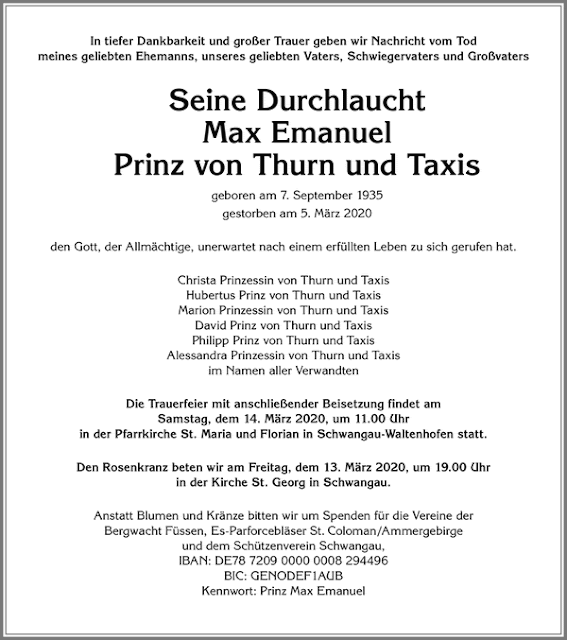HRH Princess Maria Teresa of Bourbon-Parma died today at the Hôpital Cochin Paris. She was 86 years old. The cause of death was COVID-19. The announcement was made by her younger brother, HRH Prince Sixte Enrico of Bourbon-Parma. The princess had become ill eight days earlier and was admitted to the hospital yesterday. She was in excellent health only ten days earlier and had been caring for her two sisters with the help of a nurse. Princess Maria Teresa remained in the apartment in quarantine for a week before being transferred to the hospital. She was infected by the nurse who cared for her sisters.
Princess Maria Teresa (Marie Thérèse Cécile Zita Charlotte) was born on July 28, 1933, at Paris, the third of six children of HRH Prince Xavier, Duke of Parma and Piacenza and Madeleine de Bourbon-Busset.
The princess never married. She is survived by four of her siblings: HRH Princess Francoise (Princess Edouard Lobkowicz), TRH Princess Cecilie, Princess Marie des Neiges, and Prince Sixte Enrique of Bourbon-Parma, and six nieces and nephews, Prince Carlos Xavier, Duke of Parma and Piacenza, HRH Prince Jaime of Bourbon-Parma, HRH Princess Margarita of Bourbon-Parma, HRH Princess Maria-Carolina of Bourbon-Parma (the children of the late HRH Prince Carlos Hugo, Duke of Parma and Piacenza) and HRH Princess Irene of the Netherlands) and HSH Prince Charles-Henri Lobkowicz and HSH Princess Marie Gabrielle Lobkowicz, a nun with Little Sisters of the Poor in the United States.)
 |
| TRH Prince Sixte Enrico and Princess Maria Teresa, courtesy of HRH Prince Sixte Enrico |
The Princess lived in Madrid since she was 28 years old. She was a passionate supporter of Carlism and was nicknamed the Red Princess because she espoused leftist causes. Empress Zita of Austria (nee Princess Zita of Bourbon-Parma) was her aunt and her godmother.
In 2014, she spoke with the French newspaper,
Liberation. The
Princess said her father never reigned in Spain, but "fought all of his life to put his dynasty back in the throne." She shared with her late brother, Carlos Hugo and his wife, Princess Irene, in the "oppression of financial capitalism," and became an "effervescent activist of this leftist Carlism, which dreamed of an oxymoronic socialist monarchy."
Princess Maria Teresa said: "For us, the socialist idea was not the class struggle but the permanent search for consensus."
Her passion for Carlism never came to fruition. In the late 1970s, she pursued a decorate in Hispanic Studies at the Sorbonne, and then a doctorate in Sociology in Madrid. One of her dissertation subjects was "Religious overdetermination in the political field in Ireland" and the only royal highness to subscribe to Liberation, a left-wing French newspaper.
She lived alone. According to her sister, Cecile, Marie Teresa enjoyed her independence. No affairs. Cecile responded: "She has a very high requirement. If an opportunity had arisen, she would have seized it. But nothing in line with her aspirations has distracted her from her independence cult. ”
https://www.liberation.fr/planete/2014/07/23/maria-teresa-de-bourbon-parme-princesse-rouge_1069044
In an interview with
L'Eventail, also in 2014, to promote her book,
Les Bourbon Parme, une famille engagée dans l'histoire, the princess said of her support for Carlism. "Through Carlism, I tried to evoke the problem of Spain and in the broader sense that of Europe. We have been very involved, my brother Charles-Hugues, my sisters Cécile and Marie-des-Neiges, in the rebirth of this movement which I hesitate to call "party" because it is a word that does not suit all-to -fact. If you call it that, it is very old because it dates back to 1833. Since its creation, it has consistently defended certain claims. The movement still exists as a party, but when my brother succeeded my father and was considered a legitimate king, we obviously had to leave him. Today, it is my nephew Charles-Xavier who embodies continuity. He also wrote a document when King Juan-Carlos abdicated, not a criticism but rather a proposal for a solution to the expectations of Spanish society."
https://www.eventail.be/component/k2/1594-marie-therese-de-bourbon-un-militantisme-royal#
Princess Maria Teresa wrote seven books, all on Carlism and her family. None have been translated into English.
The funeral will take place on Friday, March 27. The official announcement was released by her nephew, the Duke of Parma and does not include her eldest sister, Francoise, and her children and her younger brother, Sixte Enrico. This is due to several decades-long estrangement between the three princess and their late brother, Carlo Hugo, and Princess Francoise and Prince Sixte largely due to political issues.















































